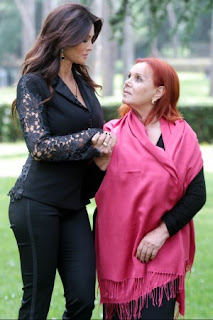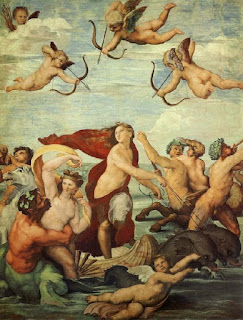TV drama star who portrayed woman who killed Mafia boss
 |
| The glamorous Manuela Arcuri has evolved from model to popular TV actress |
Arcuri portrayed a character based on Assunta ‘Pupetta’ Maresca, who made headlines in 1955 when she walked into a bar in Naples and shot dead the Camorra boss who had ordered the killing of her husband, just three months after they were married.
The four-episode drama, aired in 2013 on the Italian commercial TV channel Canale 5, was called Pupetta: Il coraggio e la passione (Pupetta: Courage and Passion). Directed by Luciano Odorisio and also starring Tony Musante, Eva Grimaldi and Barbara De Rossi, the series confirmed Arcuri’s standing as a television actress of note, winning her the award of best actress at the 2013 Rome Fiction Fest.
She had appeared by then in leading roles in a number of TV dramas and mini-series, including Io non dimentico (I Don’t Forget), Il peccato e la vergogna (The Sin and the Shame) and Sangue caldo (Hot Blood).
 |
| Manuela Arcuri met the real 'Pupetta' during the making of the 2013 series |
A girl of classic Italian beauty, she took her first modelling assignments at the age of 15 and her career as a glamour model evolved more quickly than her acting career, although she was steadily building up film credits for minor roles. Her magazine shoots led rapidly to her being projected as a sex symbol, which quickly opened doors into television, where glamorous female presenters remain a ratings winner.
In 2002, still a relative newcomer, she was given huge exposure when she was chosen to co-host the Sanremo Music Festival alongside the veteran male presenter, Pippo Baudo.
Now, bigger and better TV parts began to be offered. She participated in the popular TV drama series Carabinieri and in 2005 played the title role in Imperia, la grande cortigiana, a TV film about the 16th century Roman courtesan and celebrity, Imperia Cognati.
In 2008, she met the challenge of appearing at the Teatro Parioli in Rome in a six-week run of the comedy Il primo che mi capita, then landed her biggest TV role to that point as the female lead in Io non dimentico, a drama set in Naples in the 1930s.
 |
| The statue in Porto Cesareo that caused such controversy |
Carved by the sculptor Salvatino De Matteis, it depicts a female figure carrying a hollow shell brimming over with fish but with the hair, facial features - and cleavage - of Ms Arcuri, beneath which is an inscription that hailed the actress as a symbol of beauty and prosperity, a perfect match for Porto Cesareo itself.
Not surprisingly, the choice of an actress and glamour model over a more traditional symbol, such as a goddess or saint, or even a mermaid, divided opinion, with outspoken protests in particular by the wives of local fishermen, who had begun a daily ritual of touching the statue’s buttocks to bring them luck before they set out to sea.
For a while the statue was removed, only to later be reinstated after an equally voluble outcry from those who approved of it. Ms Arcuri, who attended the original unveiling, returned to see it reborn.
Romantically linked with a series of high-profile men, including the footballer Francesco Coco, Arcuri has had a long-term relationship with the entrepreneur Giovanni Di Gianfrancesco, with whom she had a four-year-old son, Mattia.
 |
| The Cathedral of Santa Maria Annunziata in Anagni dates back to the 11th century |
Anagni, where Manuela Arcuri was born, is an ancient town in the province of Frosinone in Lazio, 70km (43 miles) southeast of Rome in an area known as Ciociaria, named after the primitive footwear, ciocie, a type of sandal, worn by people living in the area. The town produced four popes, the last one being Boniface VIII, who was hiding out there in 1303 when he received the famous Anagni slap, delivered by an angry member of the fiercely antipapal Colonna family after he refused to abdicate. After his death the power of the town declined and the papal court was transferred to Avignon. The medieval Palace of Boniface VIII, is near the Cathedral in the centre of the town.
Search for a hotel in Anagni with tripadvisor
 |
| The Cathedral of San Marco, in the 'ideal' Fascist town of Latina in Lazio, was built in 1932 |
Latina, a town built in the middle of what used to be the Pontine Marshes, south of Rome, has been described as a living monument to Fascism - not in the sense of celebrating the horrors of the darker side of Mussolini’s grip on power, but as an example of the dictator’s utopian dreams of efficient modern cities for the Italian people. Mussolini drained the malaria-ridden Pontine swamps and gave the reclaimed land to peasants and settlers, building them houses in exchange for their labour and sweat. The centre of Latina - inaugurated in 1932 as Littoria - has been preserved almost as it was. The Fascist buildings remain in place, their rationalist architecture decorated with pagan statues as well as military and rural bas-reliefs. The Cattedrale di San Marco, designed by Oriolo Frezzotti and built in 1932, is a good example of the fusion of classical and modern, linear styles that was typical of Fascist architecture.
More reading:
The true story of Assunta Maresca - the 'little doll' who shot dead a Mafia boss
Pippo Baudo - the record-breaking host of Sanremo
Mara Carfagna - from glamour model to politician
Also on this day:
1337: The death of the brilliant painter Giotto
1921: The birth of Sicilian writer Leonardo Sciascia
2016: The death of Maria Teresa de Filippis, the first woman to drive in Formula One
Home







